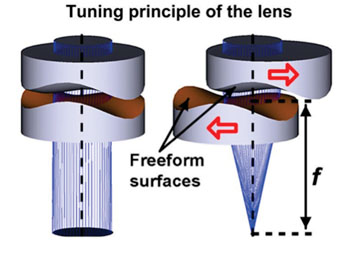Adjustable-Focus Endoscope Helps Reduce Discomfort
By HospiMedica International staff writers
Posted on 12 Aug 2015
A prototype endoscopic tunable lens system provides adjustable-focus capabilities for more effective imaging of internal tissues. Posted on 12 Aug 2015
Developed by researchers at the National University of Singapore (NUS; Singapore), the solid lens system contains two transparent polymer plates, each with one flat surface and one freeform curved surface governed by 6-degree polynomials. When the transparent plates are perfectly aligned with the inverse freeform surfaces facing each other, they behave as one unit without any focusing power; any wave phase shift induced by one is cancelled out by the other. However, when they are slightly offset sideways, they refract light like a traditional lens.

Image: Two freeform lenses provide dynamic tuning powers (Photo courtesy of Zhou Guangya/ NUS).
The system includes two slender piezoelectric benders for moving the lens elements perpendicular to the optical axis, and an image fiber bundle for transmission to an external camera monitored by a technician. The dynamic tuning provides optical powers from about 135 diopters to about 205 diopters, with no obvious distortion or blurring in the images, and with a recorded resolution of about 30 line pairs per mm. According to the researchers, these autofocus capabilities can enable an extremely compact optical zoom endoscope. The study was published in the August 2015 issue of Optics Express.
“Once successful, the miniature optical zoom endoscope with autofocus capability may allow doctors to switch conveniently from a wide field-of-view to a clear high-resolution close-up view without moving the endoscope probe,” said lead author Prof. Guangya Zhou, PhD, of the department of mechanical engineering. “This may not only reduce the complexity of the endoscopic procedure but also allow potentially high-magnification endoscopy.”
Freeform is a lens manufacturing technology that allows cutting and polishing of arbitrary surfaces; a lens is considered free-form if at least one of its surfaces is made with freeform technology and it is neither spherical nor torical. Using freeform guarantees better precision than standard plastic milling and polishing methods, and also frees manufacturers from the base-curve restrictions inherent in standard lenses since it allows a different asphericity for each lens, with optimum compensation of aberrations.
Related Links:
National University of Singapore














